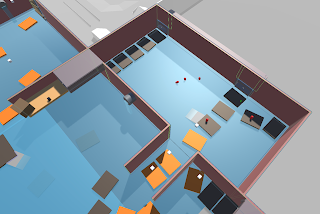Sprint 2
With the completion of Sprint 2, I have realized a lot more about Trello than I knew before, and the difficulties in using it properly. One thing that I was unsure about was how to track the work that a team member or I do that occurred on the spot, rather than planned. The process of making games sometimes takes little things that aren’t necessarily part of an existing card. For example: after connecting level 2 to level 1, I added temporary ramps for players to be able to get back up on the desks if they fall. We originally planned to have the water kill you, but due to the need to have a kinesthetic prototype done by October 26, we were prioritizing all movement mechanics and not the additional features. I have since learned that if these small tasks took more than ten minutes to complete, then track the work with a card.We were still dealing with the same GitHub issue from the last sprint. We worked around it by having the team member put his work in our shared Google Drive, so I could then put his work into the repository myself. While this wasn’t much of a problem initially, the new scripts now require certain objects in the hierarchy to have specific tags or labels. Due to this new factor, I also had to add all the necessary tags and labels myself, causing the task to take longer than it previously did. For Sprint 3, we are going to work on fixing the GitHub issue.
While we were still working around our issues with GitHub, my team and I encountered a new issue at Sprint 2 Kickoff. After our first sprint review, we learned that our movement mechanic may not be unique enough to fulfill the project requirements. We then decided that a previously mentioned feature of a grapple hand would be implemented as the main movement mechanic of the game. We were able to quickly adapt to the change.
After Sprint Kickoff, I completed the skate park. Even though our priorities changed, I wanted to complete the work I already started in the last sprint before moving on to new cards. We are hoping to implement the skate park as a sort of easter egg if we find we have the time.
Later, I began work on the third challenge of level 2. The player has to grapple into a classroom; then the player uses the detachable hand to crawl through a vent, up a wall, and push a box down from the shelf that Kevin can use to move on to the next section. I placed fake zombies and spiders in the level to give an idea of the combat that could happen in the level. I wanted the hand to have more goals than obtaining keys because it seemed like the concept would get a bit too monotonous for a player.
Since the kinesthetic prototype playtest is in Sprint 3, I am currently working on adding the keys and doors to the levels that were already blocked out. We want to have a reason for the player to use the unique movements, and putting keys in areas that the player can only reach using the grapple hand and detachable hand gives them the motivation to do so.










